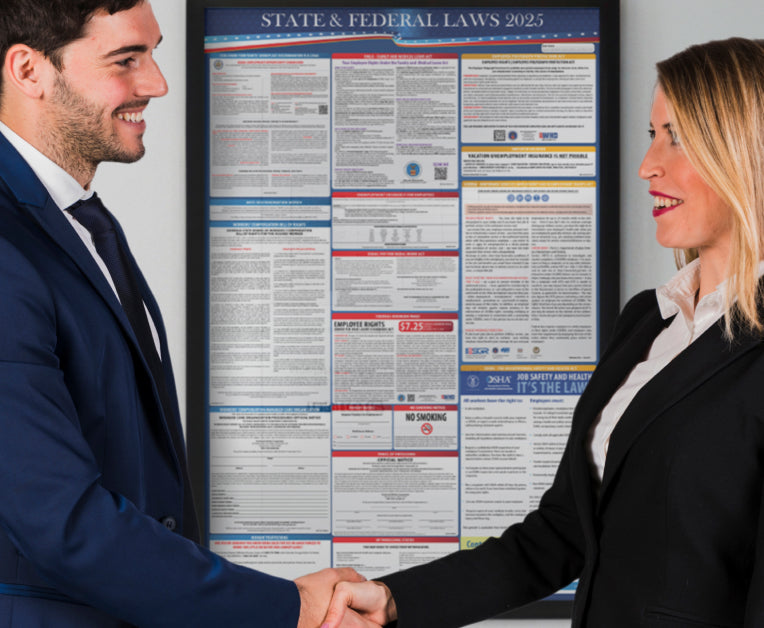
Labor Law Poster Compliance for Marketing and Advertising Agencies: Essential Guidelines
Marketing and advertising agencies are fast-paced environments where creativity, deadlines, and client expectations dominate daily operations. Amid these pressures, labor law compliance can sometimes be overlooked, particularly when it comes to displaying labor law posters. However, these posters are legally required and vital for protecting both employees and the agency itself.
This comprehensive guide explores why labor law posters are essential for marketing and advertising firms, how to display them correctly, maintain accessibility, keep them updated, and avoid legal risks. By the end, agency owners and HR managers will understand why poster compliance is not just legal—it’s a critical component of a professional workplace culture.
Why Labor Law Posters Matter in Marketing and Advertising Agencies
Advertising agencies employ diverse teams that may include creative directors, copywriters, designers, account managers, and interns. Each employee has federal and state rights that must be clearly communicated through labor law posters. These posters cover:
- Minimum wage and overtime regulations
- Workplace safety and OSHA standards
- Anti-discrimination and equal employment opportunity rights
- Family and medical leave entitlements
Properly displayed and updated posters reduce legal exposure, foster trust, and reinforce the agency’s professional standards. For guidance on poster placement, see: Why Every Small Business Must Prioritize Labor Law Poster Compliance.
Understanding Labor Law Poster Requirements

Federal Requirements
All marketing and advertising agencies must comply with federal labor posting requirements, including:
- Fair Labor Standards Act (FLSA): Minimum wage, overtime, and child labor laws
- Occupational Safety and Health Act (OSHA): Workplace safety standards
- Family and Medical Leave Act (FMLA): Job-protected leave rights
- Equal Employment Opportunity (EEO): Anti-discrimination regulations
Compliance with these federal requirements is mandatory, regardless of agency size.
State-Specific Requirements
Each state may require additional posters. Examples include:
- California: Workers’ compensation, disability insurance, and harassment prevention posters
- New York: Paid family leave and wage law posters
- Texas: Unemployment benefits and anti-discrimination notices
Marketing agencies operating across multiple states must ensure both federal and state posters are displayed and updated, or risk fines and penalties. For multi-location compliance guidance, see: Labor Law Poster Compliance for Franchise Owners: Best Practices and Guidelines.
Strategic Placement of Posters in Advertising Agencies
Correct placement ensures employees see and understand their rights. For marketing and advertising agencies, consider:
1. Common Areas and Break Rooms
Creative teams often gather in break rooms, kitchens, or collaborative spaces. Posting in these areas increases visibility and engagement.
2. Entrances and Exits
High-traffic areas like office entrances and exits maximize daily exposure to important labor law information.
3. Timekeeping and Clock-In Stations
Agencies with time-tracking systems should place posters near clocks or digital timekeeping stations, where employees frequently stop.
4. Near HR or Management Offices
Even in smaller agencies, posters near HR or management offices provide employees a point of contact for questions or clarifications.
5. Remote Teams
Marketing agencies often have remote or hybrid teams. While digital posting can supplement physical posters, physical compliance in the main office remains mandatory.
Accessibility Considerations
Advertising agencies employ diverse, often multilingual teams, so accessibility is essential:
- Eye-Level Placement: 57–60 inches from the floor ensures visibility
- Multilingual Versions: Provide translations for non-English-speaking employees
- Disability Accessibility: Use Braille, large-print, or digital formats as needed
Accessible posters enhance understanding and ensure compliance with ADA regulations.
Keeping Labor Law Posters Updated
Labor laws change frequently. Agencies must proactively update posters to avoid penalties.
Assign a Compliance Officer
Even in small agencies, designate someone to monitor labor law updates and implement changes promptly.
Automated Poster Services
Subscription services deliver updated posters automatically, saving time and ensuring compliance across all locations.
Regular Review Schedule
- Federal Updates: Check annually or upon DOL notification
- State Updates: Check when the state labor department issues changes
- Immediate Implementation: Apply updates promptly to maintain compliance
Staying updated protects agencies from risks outlined for multi-location businesses: Labor Law Poster Compliance for Franchise Owners: Best Practices and Guidelines.
Common Compliance Challenges in Marketing Agencies
Advertising agencies face unique compliance challenges due to creative environments and dynamic teams:
- High Employee Turnover: Frequent onboarding increases the need for accessible posters
- Remote or Hybrid Work: Ensuring all employees see posters, both physically and digitally
- Multiple Office Locations: Maintaining consistency across sites can be complex
- Digital vs. Physical Posting Confusion: Digital-only postings do not fulfill legal requirements
Avoiding these pitfalls requires clear policies, regular audits, and standardized procedures.
Legal and Financial Risks of Non-Compliance
Ignoring labor law poster requirements exposes agencies to serious consequences:
Fines and Penalties
Federal and state agencies can issue fines for missing or outdated posters, which accumulate quickly, especially across multiple offices.
Employee Complaints
Employees may file complaints if their rights are not visible, leading to:
- Investigations by labor departments
- Legal disputes or settlements
- Administrative costs and lost productivity
HR and Operational Burden
Non-compliance increases HR workload, diverting attention from creative projects and client work.
Reputation Damage
Agencies thrive on reputation. Non-compliance can erode employee trust and client confidence, negatively impacting long-term growth.
Best Practices for Marketing and Advertising Agencies
- Centralize Compliance Responsibility: Assign a dedicated compliance lead
- Automate Updates: Use subscription services to receive timely poster updates
- Educate Employees: Ensure staff understand where posters are and why they matter
- Accessibility: Provide multilingual, Braille, or large-print versions as necessary
- Regular Audits: Schedule quarterly or semi-annual checks to confirm posters are visible and up-to-date
Following these best practices reduces risk, promotes transparency, and strengthens workplace culture.
Digital Posting for Creative Agencies
While physical posters remain legally required, digital posting can enhance access, especially for remote teams:
- Upload posters to internal intranet or cloud portals
- Notify employees via email when updates occur
- Ensure digital copies are accessible and ADA-compliant
Digital posting supplements physical posters but cannot replace mandatory office displays.
Compliance as Part of Agency Culture

Labor law poster compliance demonstrates a commitment to ethical business practices and employee rights. For advertising agencies, this fosters:
- Employee trust and retention
- Efficient HR operations
- Professionalism to clients and stakeholders
- Reduced legal exposure
Embedding compliance into daily operations ensures agencies operate responsibly while focusing on creativity and growth.
Labor law posters are critical for marketing and advertising agencies of all sizes. Proper placement, accessibility, and timely updates protect the business, inform employees of their rights, and promote a culture of transparency and professionalism.
By implementing proactive compliance strategies—centralizing responsibility, automating updates, conducting regular audits, and ensuring accessibility—agencies can avoid fines, legal disputes, and operational disruption.


